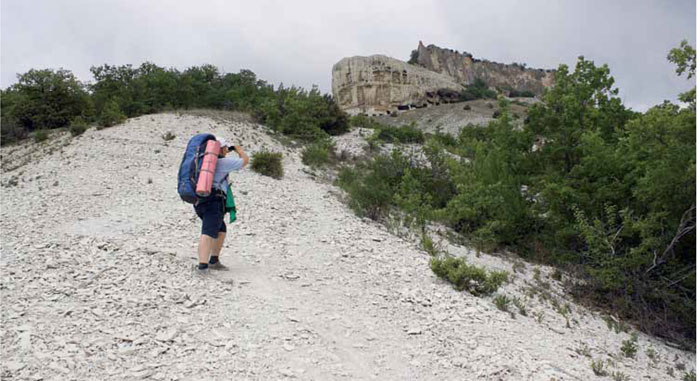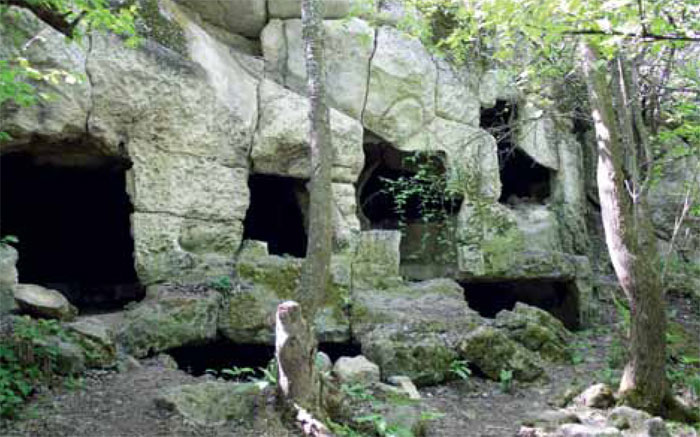The area still conceals a lot of secrets, while local medieval sites are among the least studied ones in Ukraine.
GUARDING THE BYZANTINE BORDER
The ancient settlement Tepe Kermen has been lying on top of the 530-metre-high lost mountain rising over the Kacha River Valley for about ten million years. The 1 ha plateau contains around 250 cave formations. Here is what scientist Johann Erich Tunmann wrote after a visit to the Crimea in 1777: “Tepe Kermen, meaning a castle on the peak, is a high, large mountain which looks like a sugar head, on top of which one can still see the remnants of a very ancient fortress. The whole rock is covered with numerous grottos and caves, placed in a special order, almost like an ancient necropolis…”
Tepe Kermen stands for ‘hill fortress’ or ‘peak fortress’ in Crimean Tartar. The construction probably dates back to the 6th century, when Emperor Justinian I decided to strengthen the northern border of the Byzantine Empire. However, there is another version which says Tepe Kermen was founded by migrant monks from northern regions of the Empire.
It was around the 10th century that Tepe Kermen turned into a ‘classical’ medieval urban centre, with its settlements surrounded by strong defensive walls and filled with surface-mounted stone constructions. At the final stage of the city’s history the majority of the cave spaces were used for household activities, in particular as cattle sheds, food and military storehouses and even as tanks for water storage. The decline of the settlement is dated near the end of the 13th, or the beginning of the 14th centuries. According to some versions, in spite of the advantageous strategic location of the city, Tepe was taken by storm and practically wiped off the face of the earth by the Tartar Golden Horde troops of Isa Nogai.

ONCE SEEN, NEVER FORGOTTEN
“Going to Tepeshka?” a woman asked us, seeing three confused tourists with enormous back packs. “It’s just that guests are quite rare here, even in the holiday season… You should turn to the left after passing the village, and then you’ll be five kilometres from the site,” she added and disappeared behind her garden gate. Nearby we saw a mule tied to the fence, which looked really exotic to us tourists from the capital.
Finally we found three paths and after a little wandering through an oak forest we saw a wide lawn overgrown by weeds. There was a fantastic view of a plateau which looked severe and unapproachable. “So, here’s Tepe! The landscapes are really cool here,” all of us said.

We had to climb quite an arduous hill, but we were then rewarded with the most incredible landscape of the Crimean Mountains and a beautiful orange sunset which gave a slight inner glow to the snowy peaks.
Having chosen a wide cave we pitched our tent, started a fire and turned on our flashlights to look around. We found the following line of pencil inscriptions: 1912, 1940, 1961, 1970. Later it became clear these were the years of large-scale archaeological excavations. It is worth mentioning that the research into the caves was almost limited to these excavations, which resulted in questions mostly, rather than in answers, for the researchers of Crimean antiquity. It is also interesting that neither the cave city, nor the whole locality within a 4-kilometre radius, present the visitor with any water source. If there was one, it dried up a long time ago. According to one Tepe Kermen researcher, it might have been the very reason for the end of the almost half a thousand year history of the city fortress.

In spite of the distinct lack of water on the plateau and a definite shortage of natural fuel for fire, Tepe Kermen has been the home for many months now for one contemporary girl we met there. “You must know everything here!” – “Of course, I do, I’ve been living on Tepe for almost a year,” the confident young girl, looking somewhat marginal, told us. She came to our cave to get acquainted with and inform the new ‘guests’ of local peculiarities. “You definitely have to visit the cave temple, the ‘aborigine’ went on, as far as I know, it was carved in the 5th or 7th century and is well preserved,” she said disappearing as unexpectedly as she had come.

We tried hard to find the unremarkable, half-covered entrance to the recommended cave temple and it was such a true reverence of discoveries when we did, that we felt ourselves practically jumping for joy inside. We expected to see a ‘classical’ small cave of the mountainous Crimea with some remnants of an altar and a couple of religious ‘attributes’ perhaps, but we were surprised to see a spacious light area with several niches on the floor and on the wall, numerous carved crosses and, what is more, a uniquely preserved baptismal place and columns. ‘The church with baptistery’, this is how this site is called in numerous Tepe Kermen guides, is dated from the 11th or the 12th centuries, according to researchers. It is worth mentioning a cave temple of this sort is a unique site, not only for the Crimean peninsula or Ukraine, but for the whole Eastern Europe! The temple is unique due to its interior, which can only be seen in some cave temples of Cappadocia, Anatolia (on the territory of modern Turkey) and Syria. Besides this, archaeologists have found numerous half-effaced Greek, Armenian and even ancient Jewish inscriptions on the walls of the church. Nowadays there is no ancient graffiti here, but you can easily see carved inscriptions saying ‘Kharkiv’, ‘1910’ with no protection plate or signs nearby…

Besides this cult site, there are several cave temples on the plateau. The so called ‘church with sacristy’ dating from the 12th and the 13th centuries was the best preserved of all. In general it is now known that Tepe Kermen sacral sites were not abandoned, even after the decline of the city, they were widely used by the Greek population of the nearest valleys and some hermit monks, which was proven by researchers’ accidental discovery of monk Mykolay’s epitaph dated in the 16th century.

Though ancient sites and the ‘un-researched area’ of Tepe Kermen are not the reason for its popularity among tourists, it really is a rather incredible landscape opening from the plateau peak. Everyone, who has had an opportunity to see a sunset or sunrise here, will never forget it. “How do you like the scenery?” a smiling tourist travelling by himself asked us. “It is marvellous, isn’t it? I’ve been coming here regularly for 20 years and you’re going to come back here too, you’ll see. You will surely come back… So, would you like some cognac?” We could not help but accept the proposition, having no desire to say no.

